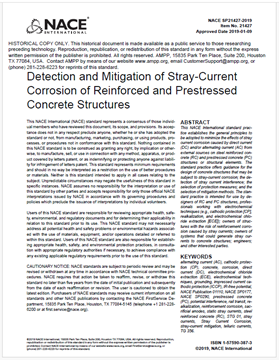Search
Products tagged with 'sacrificial anodes'
View as
Sort by
Display
per page
51318-10912-Comparative Evaluation of Various Types of Metallic Coatings for Structural Steel in Marine Enviro
Product Number:
51318-10912-SG
Publication Date:
2018
$20.00
51318-11378-Improving Al-Ga Sacrificial Anodes via Simulation and Verification of Alloy Segregation.
Product Number:
51318-11378-SG
Publication Date:
2018
$20.00
Advanced Subsea Corrosion Protection via Modulated Impressed Current Cathodic Protection a Prototype Demonstration and Comparative Evaluation
Product Number:
51324-20812-SG
Publication Date:
2024
$40.00
Break Reduction/Life Extension for Municipal Water Pipelines
Product Number:
51324-20658-SG
Publication Date:
2024
$40.00
Cathodic Protection -Based Solutions For Corrosion Prevention Of “Green Aluminum” Alloys
Product Number:
51322-17823-SG
Publication Date:
2022
$20.00
Corrosion Assessment to Extend Vessel Continuous Operation Subsequent to Depleted Anodes Indications
Product Number:
51323-18992-SG
Publication Date:
2023
$20.00
Investigation of the Electrochemical Behavior of Al-Zn-Bi based Sacrificial Anode in Artificial Seawater
Product Number:
51323-19472-SG
Publication Date:
2023
$20.00
NACE SP0216-2016, “Sacrificial Cathodic Protection of Reinforcing Steel in Atmospherically Exposed Concrete Structures.”
Product Number:
21403-SG
Publication Date:
2016
$179.00
NACE SP21427-2019 “Detection and Mitigation of Stray-Current Corrosion of Reinforced and Prestressed Concrete Structures”
Product Number:
21427-SG
Publication Date:
2019
$179.00
RP0387-1990, Metallurgical and Inspection Requirements for Cast Sacrificial Anodes for Offshore Applications
Product Number:
53055-HD1990
ISBN:
1-57590-081-5
Publication Date:
1990
$179.00
SP0387-2019 Metallurgical and Inspection Requirements for Cast Galvanic Anodes for Offshore Applications
Product Number:
21036-SG
ISBN:
1-57590-081-5
Publication Date:
2019
$109.00
SP0387-HD2014 Metallurgical and Inspection Requirements for Cast Galvanic Anodes for Offshore Applications
Product Number:
21036-HD2014
ISBN:
1-57590-081-5
Publication Date:
2014
$179.00
- 1
- 2












